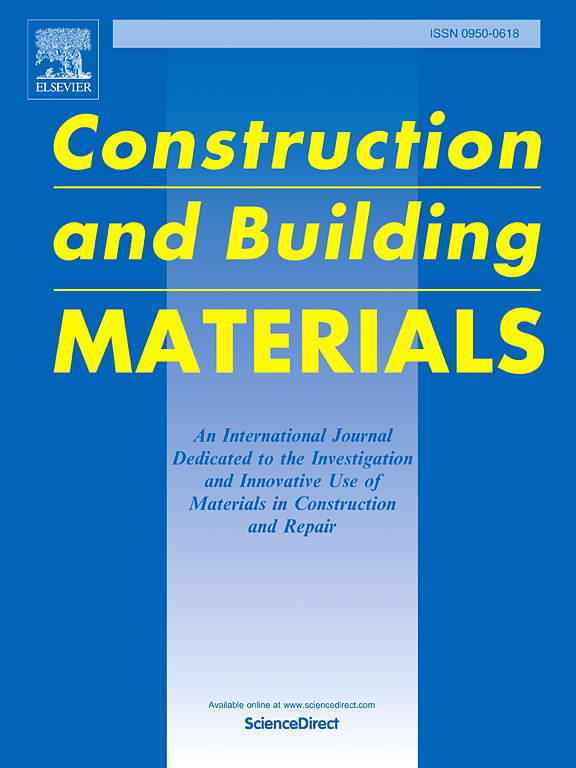应力和试件几何形状对硬化水泥膏体三点弯曲DMA的影响
IF 8
1区 工程技术
Q1 CONSTRUCTION & BUILDING TECHNOLOGY
引用次数: 0
摘要
动态力学分析(DMA)是研究毫米胶凝试件短期粘弹性行为的重要工具。在可用的配置中,三点弯曲特别适合硬材料,如硬化水泥浆。然而,与其他材料类别不同,在这种情况下,实验变量(如应力水平和试样几何形状)的影响尚未得到定量评估,限制了DMA数据的可靠性和有用性。本研究通过评估静态和动态应力以及试样几何形状如何影响三点弯曲DMA测试中的存储模量和损失切线来解决这一差距。首先建立了DMA操作范围,以保证测量的有效性。在1 Hz和25°C下,分别对三组几何形状不同、静、动应力分别独立和共同变化的矩形试件进行了试验。静应力和动应力的作用相反,且呈对数趋势。一个统一的对数模型被成功地应用于捕获这些影响,使用一个简单的分析形式,依赖于最大应力和应力比,这是一种以前没有报道的方法,用于胶结材料的DMA。几何效果与干燥和碳化有关,突出了该技术对环境相互作用的敏感性。讨论了与可逆短期蠕变相一致的微观组织机制。最后,提出了指导未来DMA测试协议的实用建议。本文章由计算机程序翻译,如有差异,请以英文原文为准。
Influence of stress and specimen geometry on three-point bending DMA in hardened cement pastes
Dynamic Mechanical Analysis (DMA) is a valuable tool for studying short-term viscoelastic behaviour in millimetric cementitious specimens. Among available configurations, three-point bending is particularly suited for stiff materials like hardened cement paste. However, unlike in other material classes, the influence of experimental variables such as stress levels and specimen geometry has not been quantitatively assessed in this context, limiting the reliability and usefulness of DMA data. This study addresses this gap by evaluating how static and dynamic stresses, as well as specimen geometry, affect storage modulus and loss tangent in three-point bending DMA tests. The DMA operational range was first established to ensure measurement validity. Tests at 1 Hz and 25°C were conducted on three groups of rectangular specimens with distinct geometries, varying static and dynamic stresses independently and jointly. The effects of static and dynamic stress were found to be opposite and followed a logarithmic trend. A unified logarithmic model was successfully applied to capture these effects using a simple analytical form, dependent on maximum stress and stress ratio, an approach not previously reported for DMA in cementitious materials. Geometry effects were linked to drying and carbonation, highlighting the technique’s sensitivity to environmental interactions. Microstructural mechanisms consistent with reversible, short-term creep were discussed. Finally, practical recommendations were proposed to guide future DMA testing protocols.
求助全文
通过发布文献求助,成功后即可免费获取论文全文。
去求助
来源期刊

Construction and Building Materials
工程技术-材料科学:综合
CiteScore
13.80
自引率
21.60%
发文量
3632
审稿时长
82 days
期刊介绍:
Construction and Building Materials offers an international platform for sharing innovative and original research and development in the realm of construction and building materials, along with their practical applications in new projects and repair practices. The journal publishes a diverse array of pioneering research and application papers, detailing laboratory investigations and, to a limited extent, numerical analyses or reports on full-scale projects. Multi-part papers are discouraged.
Additionally, Construction and Building Materials features comprehensive case studies and insightful review articles that contribute to new insights in the field. Our focus is on papers related to construction materials, excluding those on structural engineering, geotechnics, and unbound highway layers. Covered materials and technologies encompass cement, concrete reinforcement, bricks and mortars, additives, corrosion technology, ceramics, timber, steel, polymers, glass fibers, recycled materials, bamboo, rammed earth, non-conventional building materials, bituminous materials, and applications in railway materials.
 求助内容:
求助内容: 应助结果提醒方式:
应助结果提醒方式:


